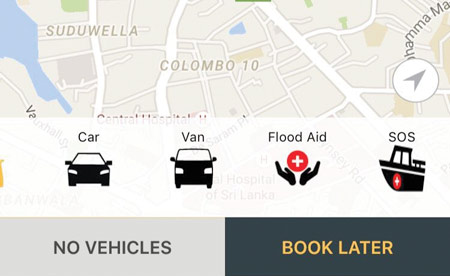Doing their bit to help
When Sri Lanka was reeling under its worst disaster
in a decade, taxi-calling services were dropping off relief supplies for
free. Others were helping citizens find trustworthy aid agencies to
which to make donations.
by Shiran Illanperuma
As Sri Lanka struggles to deal with the devastation caused this week
by Cyclone Roanu, which left floods, landslides and a 101 people dead in
its wake, citizens were busy pitching in to help with government relief
initiatives. Assisting with these efforts were local start-ups.
 “As start-ups, we can bring to the table innovations, new technology
and new thinking,” said Jiffry Zulfer, Chief Executive Officer of PickMe,
a local taxi-hailing app in the vein of Uber and Ola. “As start-ups, we can bring to the table innovations, new technology
and new thinking,” said Jiffry Zulfer, Chief Executive Officer of PickMe,
a local taxi-hailing app in the vein of Uber and Ola.
Less than 24 hours after a landslide on 17 May flattened the inland
town of Aranayake, located over 100 km east of Colombo, PickMe
introduced a “flood relief” button that allowed users to call for a
vehicle to pick up donations and have them delivered to the Sri Lankan
Red Cross, free of charge.
A day later, the start-up introduced an “SOS” button so that those
trapped by floods and landslides could mark their location via GPS and
call for help. The feature led to over a thousand requests and 150
successful boat rescues, company officials said. The app has also
introduced an “air lift” button, which resulted in 40 requests and three
successful rescue attempts, again through the use of GPS.
“We redirected SOS and air lift requests to the military who managed
it from there, but we’ve heard moving stories of pregnant women and
children being rescued, thanks to the use of GPS technology,” said
PickMe CEO Zulfer.
Accurate information
Start-up content platforms also played a large role in helping to
provide accurate and up-to-date information in the country’s worst
natural disaster in a decade, and helped residents find trustworthy aid
agencies through which they could channel donations.
Roar.lk, a news and current affairs website launched in 2014, set
about running a live blog in the wake of the floods, providing viewers
with information from a plethora of sources, including state agencies,
mainstream media and Facebook and Twitter. Though live blogs are common
enough in other places, no mainstream Sri Lankan news site had adopted
the format before in response to disasters.
“Social media has been useful in helping to mobilise relief movements
but can also be a den of misinformation,” said Gazala Anwer, the
Editor-in-Chief of Roar.lk. “The unethical use of social media could
lead to needless panic as it did when rumours spread yesterday of water
and fuel cuts. What we tried to do was cut through the noise and try to
offer a stream of accurate updates.”
Another start-up, food and travel website, Yamu.lk, responded to news
of the floods by posting a “How to help” page, a day after news of the
landslides in Aranayake. The page lists charitable organisations and
relief efforts for people to donate to or engage with and was also
translated into Sinhala. The post has since received over 15,000 views,
with dozens adding to the list in the comments section.
“We’re a food website but we ended up doing coverage of the floods
because of the spread of bad information,” said Yamu.lk Director,
Indrajit Samarajiva. “Social media is important but it exists in an
ecosystem that requires other parts like government co-ordination to
work. Sri Lankans are wonderful during crises and social media has
helped mobilise an immediate response, but without co-ordination, a lot
of resources are going to places that no longer need them.”
Rescue teams under-equipped
Though citizens are doing their bit, the efforts are, as to be
expected, being headed by the official agencies. Ironically, the state
forces appeared to be under-trained and lacking access to the same level
of technology as some of the Colombo-based start-ups.
This appeared evident when images posted online by journalists showed
young soldiers wading waist-deep through mud at the Aranayake disaster
site, using only wooden sticks to prod debris in search of buried
survivors and the bodies of the dead.
Said Zulfer of the PickMe taxi service: “When we hit the ground, some
of them were surprised at the level of technology and expertise we had
to offer. But we were happy pool our resources with the state to
speed-up relief and recovery efforts.”
For many, images of the floods and landslides evoke unhappy memories
of the devastating 2004 Indian Ocean tsunami. But much has changed since
then. “We are now better equipped to deal with recovery exercises than
ever before,” said Zulfer.
Scroll.in
|

